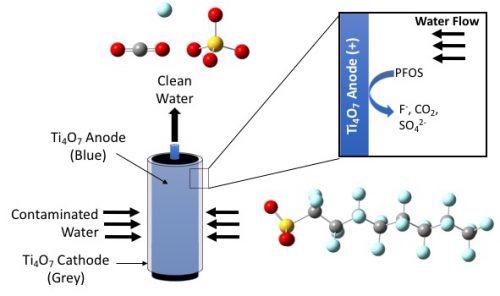New Reactive Electrochemical Membrane to Adsorb and Degrade Toxins
Published on by Water Network Research, Official research team of The Water Network in Technology
At the University of Illinois Chicago (UIC), scientists have designed a reactive electrochemical membrane with the ability to adsorb toxins and degrade them. The team is currently testing the technology in the field.

New reactive electrochemical membrane (REM) filtration technology developed at UIC converts traditional filtration membranes into a reactive surface. The small pores, or holes, in the membrane will trap contaminants and the application of electricity to the membrane will cause reactions that will break contaminant molecules apart. Image Credit: University of Illinois Chicago.
They believe that the new technology will prove to be an effective tool for eliminating perfluoroalkyl substances from groundwater.
Perfluoroalkyl substances, also called PFAS, are artificial chemicals found in several common materials, such as non-stick coatings, stain- and water-resistant materials, and some food packaging. Although PFAS are common in industrial societies such as the United States, they can have detrimental health impacts.
Such effects are exacerbated when huge concentrations of the chemicals reach drinking water and groundwater, for example, in areas next to landfills or some manufacturing or testing facilities.
There is evidence that the compounds can result in high cholesterol and cancer, and have impacts on the reproductive and immune system and thyroid. Such compounds are utilized in aqueous film-forming foams, which are utilized and at times essential to suppress fires.
The U.S. Department of Defense has utilized fire-fighting foams and the department’s Strategic Environmental Research and Development Program, or SERDP, has granted UIC $1 million to improve the technology and eliminate PFAS from groundwater next to testing sites across the country.
There are very few methods of treating water to destroy contaminants like PFAS . One of the most effective methods to date is to use a process called REM filtration .
Brian Chaplin, Associate Professor of Chemical Engineering, College of Engineering, University of Illinois Chicago
Reactive electrochemical membrane filtration, or REM filtration, involves treating water by making it pass via an electrically charged membrane to encourage electrochemical reactions.
This electrochemical reaction is what our technology seeks to optimize and tailor, and we are applying the technology for PFAS compounds . Most available systems adsorb or filter the chemicals, but have no way to eliminate—they are generally considered ‘forever chemicals’ because they just move from one material to the next and never substantially degrade. Our technology advances methods for removing and, notably, degrading the compounds .
Shafigh Mehraeen, Assistant Professor of Chemical Engineering, University of Illinois Chicago
Related Stories
- Understanding the Effect of Hydrogen Impurities on Polymer Electrolyte Membrane Fuel Cell Performance Using Mass Spectrometry
- Ion Complex Membranes of Acrylonitrile Copolymers Having Methacrylic Acid and Amphiphilic Quaternized Ammonium Groups for Uracil Molecular Imprinting
- Membrane Inlet Mass Spectrometry (MIMS): Using Mass Spectrometers to Detect Nitric Oxide
Mehraeen and Chaplin made use of innovative materials—a ceramic membrane featuring a huge surface area—to adsorb and disintegrate the compounds from water, as part of a new REM treatment process.
They have created computer simulations to gain insights into the adsorption and degradation mechanisms of the compounds.
The technology transforms conventional filtration membranes into a reactive surface.
The small pores, or holes, found in the membrane will capture PFAS, and applying electricity to the membrane will induce reactions that will split the PFAS molecules.
The team will be using the technology in the field, thanks to the new financial support. They believe that the new technology will be more effective at removing PFAS and decreasing threats to close communities compared to existing techniques.
If we are successful, this technology could be leveraged in numerous ways to keep communities and the environment free from harmful levels of PFAS .
Shafigh Mehraeen, Assistant Professor of Chemical Engineering, University of Illinois Chicago
“ Compounds like PFAS need to be managed at a systems level to reduce their impact on public health, and this technology has the potential to enhance the government’s and industry’s ability to do so effectively ,” concluded Chaplin.
Taxonomy
- PFAS